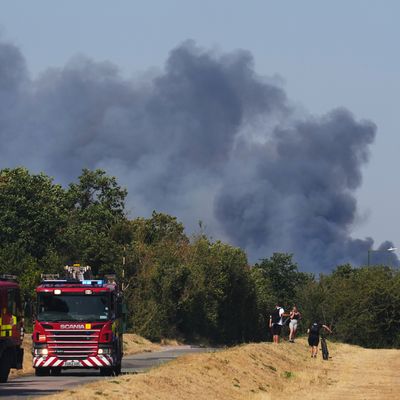
A historic heat wave is continuing to scorch western Europe, where the extreme weather has broken countless temperature records, worsened already severe drought conditions, fueled dozens of wildfires, and killed more than 1,000 people. Although some of the region finally began cooling off on Monday as the heat wave shifted east, the U.K recorded its highest temperature ever on Tuesday — 40.3 degrees Celsius (104.5 degrees Fahrenheit) — and the heat has led to at least ten grassfires in the greater London area. Temperatures will cool off overnight in the U.K. as the heat wave moves toward Belgium, Germany, and the Netherlands. The extreme heat is a particularly dangerous weather event, because the vast majority of homes in the U.K. do not have air-conditioning. Temperature records have already been set in multiple European countries over the past week. This is the second historic heat wave to strike the continent this year. Scientists have linked the extreme weather to climate change.
Parts of greater London burst into flames as U.K. temperatures surpass 40 degrees Celsius for first time ever
Heathrow Airport recorded a new U.K. temperature record of 40.2 degrees Celsius on Tuesday afternoon. The record didn’t last long: A temperature of 40.3 degrees was later recorded in Coningsby in Lincolnshire. (The previous heat record was 38.7 degrees in the summer of 2019.) Tuesday’s brutal heat led to at least ten fires breaking out across the greater London area, prompting the London Fire Brigade to declare a major incident.
The heat wave has caused severe disruptions in the U.K., where the government issued its first-ever extreme-heat “red warning” for much of the country on Monday and Tuesday, advising people to work from home, avoid using roadways and public transit, and do whatever it takes to stay hydrated and cool. Many schools have been closing early. On the rail system, including the Tube in London, trains are operating at reduced speeds out of justified fear that the heat will warp the tracks.
Hospitals are canceling surgeries, because operating rooms are too hot. And in some places, road crews have been preparing to spread sand on road surfaces to prevent them from melting. That’s a problem at least two U.K. airports have already experienced: Luton Airport suspended flights on Monday after a heat-related defect was discovered on its runway, and Sky News reports that a runway has “melted” at the nation’s largest airbase, RAF Brize Norton, forcing it to shift air traffic to other airfields.
For people in the U.K., staying cool may be difficult: Only 1 percent of U.K. buildings have built-in air-conditioning systems and no more than 5 percent have portable AC systems, according to the Financial Times.
Temperatures are expected to drop close to seasonable norms after Tuesday, but the notoriously cold country is getting a wake-up call about its future climate.
Ongoing record heat in France
On Monday in France, some 64 new temperature records — including many over 40 degrees Celsius — were set across the country, primarily in western France along the Atlantic coast. Though much of the country cooled down on Tuesday, at least five more temperature records were broken, and it remained over 40 degrees in Paris into the evening.
Wildfires are spreading in multiple countries
Firefighters in southwestern Europe are being pushed to the limit as wildfires rapidly spread amid the extreme heat. More than 1,700 firefighters are still trying to contain a pair of massive fires in France’s southwestern Gironde region that started last week and have already burned 47,000 acres and forced the evacuation of more than 31,000 people.
More than 30 fires are burning across multiple regions of Spain. Fires in the Mijas hills (near Málaga) in the southern Andalusia region have forced the evacuation of some 3,000 people. Other wildfires are spreading in Spain’s west and northwest Extremadura, Castilla y León, and Galicia regions.
And in Portugal, where a national-record temperature of 47 degrees Celsius (116.6 degrees Fahrenheit) was recorded on Thursday, 1,000 firefighters are trying to contain more than a dozen fires in the country’s central and northern regions — though cooler weather helped with those efforts on Monday.
The heat wave has fueled wildfires throughout the Mediterranean — including on Croatia’s Adriatic coast, in Italy, on the Greek island of Crete, in southwest Turkey, and in northern Morocco.
An exacerbated drought crisis in Italy
A heat wave was the last thing Italy needed. In Northern Italy, the worst drought in 70 years had already reduced parts of the Po river to a trickle, prompting the government to declare a state of emergency across one of the country’s most important agricultural regions. The river, which flows east from the Alps to the Adriatic Sea near Venice, is not only the nation’s longest waterway but a critical source of water for residents, farmers, and hydroelectric power.
The Po river basin (home to a third of Italy’s population, more than half of its cattle, and nearly two-thirds of its pigs) typically produces about 30 percent of the country’s annual agricultural output — including rice, wheat, ham, and cheese. The drought, which is the result of unprecedented high temperatures and a severe three-year precipitation deficit, has led to widespread water rationing, has already devastated the region’s rice industry, and is expected to do some €3 billion in damage.
This post has been updated.






























